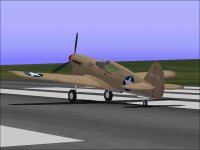Merlin versus Allison
The Merlin Warhawk model is pretty close to completion at this point.
It will represent a P-40F-1. The F-5 was the first Long Tail version.
A couple days ago, I started gathering information for the Flight Model for the F-1.
As one might expect, the majority of the changes are to the Engine Parameters considering that this was basically just an engine swap from the P-40E.
The following are the obvious changes:
The Allison was also designated the V-1710.
The Merlin was designated the V-1640 in US service.
The slight difference in displacement was due to the slightly lesser Bore of the Merlin.
5.4 inch on Merlin versus 5.5 inch on Allison. For the AIR file, each Cylinder would have 137.41326 Cubic Inches displacement.
There was also a difference in Compression.
The Merlin typically used a 6.0:1 Compression while the Allison was typically 6.65:1.
This difference in compression might explain why it was easier to supercharge the Merlin.
Both engines had a maximum of 3000 RPM which makes the next item a bit surprising.
The Propellers appear to be the same across the two models, but....
The Reduction Gearing on the Allison was 0.500 while the Merlin installed in the Warhawk was 0.447
The Pitch Range also differed slightly from 24.5 to 54.5 degrees in the Allison P-40 to 26.5 to 56.5 degrees for the Merlin.
Take-Off Rating
54.3 inches Hg - 1300 HP - 3000 RPM
Military Rating
48.2 inches Hg - 1240 HP - 3000 RPM
WEP Rating
51.0 inches Hg - 1300 HP - 3000 RPM.
There is a lot more data for power settings available. They differed slightly in British as versus American service.
Listed Climb Rates are barely over 2000 ft/min but typically not for full power operation (48 inches Hg - 2850 RPM)
Maximum speeds are 355-365 MPH but again are not at maximum power settings. One test recorded a maximum speed of just over 370 MPH which was probably done at maximum power.
To Be Continued.....
The Merlin Warhawk model is pretty close to completion at this point.
It will represent a P-40F-1. The F-5 was the first Long Tail version.
A couple days ago, I started gathering information for the Flight Model for the F-1.
As one might expect, the majority of the changes are to the Engine Parameters considering that this was basically just an engine swap from the P-40E.
The following are the obvious changes:
The Allison was also designated the V-1710.
The Merlin was designated the V-1640 in US service.
The slight difference in displacement was due to the slightly lesser Bore of the Merlin.
5.4 inch on Merlin versus 5.5 inch on Allison. For the AIR file, each Cylinder would have 137.41326 Cubic Inches displacement.
There was also a difference in Compression.
The Merlin typically used a 6.0:1 Compression while the Allison was typically 6.65:1.
This difference in compression might explain why it was easier to supercharge the Merlin.
Both engines had a maximum of 3000 RPM which makes the next item a bit surprising.
The Propellers appear to be the same across the two models, but....
The Reduction Gearing on the Allison was 0.500 while the Merlin installed in the Warhawk was 0.447
The Pitch Range also differed slightly from 24.5 to 54.5 degrees in the Allison P-40 to 26.5 to 56.5 degrees for the Merlin.
Take-Off Rating
54.3 inches Hg - 1300 HP - 3000 RPM
Military Rating
48.2 inches Hg - 1240 HP - 3000 RPM
WEP Rating
51.0 inches Hg - 1300 HP - 3000 RPM.
There is a lot more data for power settings available. They differed slightly in British as versus American service.
Listed Climb Rates are barely over 2000 ft/min but typically not for full power operation (48 inches Hg - 2850 RPM)
Maximum speeds are 355-365 MPH but again are not at maximum power settings. One test recorded a maximum speed of just over 370 MPH which was probably done at maximum power.
To Be Continued.....



















